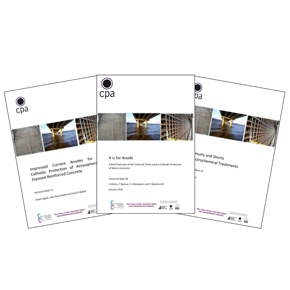
CPA publish new guide on cathodic protection and electrochemical treatments
The Corrosion Prevention Association (CPA), part of the Structural Concrete Alliance, has published a number of guides to help users understand available cathodic protection (CP) and electrochemical treatments for structures.
Technical Note 11: Impressed Current Anodes for the Cathodic Protection of Atmospherically Exposed Reinforced Concrete provides a summary of the anode systems commercially available in the UK. Aimed at specifiers and asset managers with overall responsibility for structures, the document details the main features of each system including installation, application and performance.
Current cathodic protection is used primarily to provide corrosion control on reinforced concrete structures suffering from reinforcement corrosion and is also applied to 20th century steel framed masonry and brick clad buildings and monuments.
The document categorises the anode systems into six main types: conductive organic coatings; thermal sprayed zinc; coated titanium expanded mesh/mesh ribbon in a concrete overlay; coated titanium expanded mesh ribbon – mortared into slots chased into the concrete or embedded in new construction; internal conductive ceramic titania or coated titanium (discrete) anodes; and conductive cementitious overlay containing nickel coated carbon fibres.
Technical Note 11 stresses that anode specification should be made by a qualified Cathodic Protection Engineer, with a Level 3 certification to BS EN 15257 in cathodic protection of steel in concrete.
The CPA has also published a glossary of technical terms used in cathodic protection of steel in concrete, Technical Note 28: A is for Anode, in addition to new guidance on the impact of continutity and and shorts on the efficiency and continued performance of such a systems, titled Technical Note 25: Continuity and Shorts in Electrochemical Treatments.
The document explains the effect of shorts and steel discontinuity on electrochemical treatments, including mpressed current and galvanic cathodic protection, chloride extraction, re-alkalisation, and hybrid treatments using a temporary power supply.
Corrosion Testing of Concrete Structures
The CPA has also published Technical Note 27: Corrosion Testing of Concrete Structures to explain how to assess corrosion risk and make informed decisions about repair strategy based upon a broad base of information.
Corrosion is commonly caused by a number of variables: changes in the concrete permeability, caused by local differences in composition, compaction and curing; construction errors leading to areas with low concrete cover to reinforcement; and variation in the exposure environment, leading to areas with elevated chloride ion content or high carbonation depth.
Technical Note 27 states that corrosion testing should help to develop an understanding of the exposure variability, ascertain risk and help prepare a repair and maintenance strategy. It also explains that delamination and visual surveys are the most common methods used for ascertaining risk – but these alone cannot determine corrosion risk over the entire structure.
The findings of these surveys should be used to select or target representative locations for further testing, such as closer grid half cell potential surveys; screening for chloride and other contamination; testing for depths of carbonation; corrosion rate monitoring; or concrete resistivity testing.
Visit the Structural Concrete Alliance website
Visit Supplier's page
Latest news

21st February 2025
ASSA ABLOY EMEIA: Save valuable time and money with a seamless switch to programmable digital keys
In 2025, access management can be a whole lot easier. By making access part of their digital processes, businesses can put time-consuming key management and the cost of changing the locks firmly behind them. Making this switch is a lot easier than many people think, as ASSA ABLOY explains here…
Posted in Access Control & Door Entry Systems, Architectural Ironmongery, Articles, Building Industry News, Building Products & Structures, Building Services, Doors, Facility Management & Building Services, Health & Safety, Information Technology, Innovations & New Products, Retrofit & Renovation, Security and Fire Protection
21st February 2025
Showersave supports industry leaders in addressing Part L and Part G regulations
Showersave has sponsored and participated in a recent Building Insights LIVE roundtable on ‘Water & Energy Saving Innovations in New Build Housing’.
Posted in Articles, Bathrooms & Toilets, Bathrooms, Bedrooms & Washrooms, Building Associations & Institutes, Building Industry Events, Building Industry News, Building Products & Structures, Building Regulations & Accreditations, Building Services, Exhibitions and Conferences, Interiors, Pipes & Fittings, Plumbing, Retrofit & Renovation, Sustainability & Energy Efficiency
21st February 2025
GEZE: The importance of Specifying High Quality Door Closers on Fire Doors
Andy Howland, Sales & Marketing Director at GEZE UK, discusses why specifying high quality door closers on fire doors is important…
Posted in Access Control & Door Entry Systems, Accessibility, Architectural Ironmongery, Articles, Building Industry News, Building Products & Structures, Building Regulations & Accreditations, Building Services, Doors, Facility Management & Building Services, Health & Safety, Posts, Restoration & Refurbishment, Retrofit & Renovation, Security and Fire Protection
21st February 2025
Insight Data achieves ISO9001 recertification with zero non-conformities
Leading industry data specialist, Insight Data, has successfully achieved the prestigious recertification for ISO9001 with zero non-conformities for the fourth consecutive year.
Posted in Articles, Building Industry News, Building Regulations & Accreditations, Building Services, Information Technology, Research & Materials Testing
 Sign up:
Sign up: